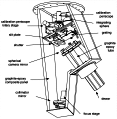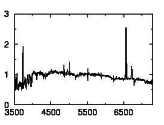
|

FAST Spectrograph
|

|
FAST: A High-Throughput Spectrograph for the Tillinghast1.0 Introduction1.1 Spectrograph CharacteristicsFAST has a conventional plane reflection grating geometry with an off-axis parabolic collimator and a Schmidt camera. The focal length of the collimator is 963 mm and the effective focal length of the camera is 328 mm, giving a reduction of 2.93, corresponding to a scale of 0.57 arcsec/15µ pixel along the slit. The unvignetted slit length is 3 arcminutes, or 13.72 mm at the slit. The angle between the collimated beams arriving at and leaving the grating is 35°. The layout of the spectrograph is shown in Figure 1.1.2 GratingsFAST is designed to accept gratings with rulings between 300 and 1200 lines per mm in first order. Table 1 gives the resolutions and spectral coverages for various gratings with a 40 mm long CCD, such as the Loral 51222688. The spectrograph will vignette at the spectral extremes if a grating with an anamorphic factor exceeding 1.3 is used. This corresponds to a 1200 line grating centered at Hα, so that the use of a 1200 line grating in the extreme red will entail a modest loss in efficiency.
1.3 EfficiencyFAST has been designed for high throughput between 3700 and 9000Å, making use of high efficiency antireflection coatings and UV enhanced, over coated silver coatings for the mirrors. With a thinned, back-side illuminated CCD with antireflection coating, the peak efficiency (including detector) will exceed 40%. With a thick, front side illuminated CCD, the peak efficiency reaches ¸20%, but falls off severely in the blue. Figure 3 gives a plot of the efficiency versus wavelength with the current thick CCD, as well as the anticipated future performance with a thin CCD.1.4 CCD CharacteristicsThe initial CCD is a Loral 51222688 chip with 15¯ pixels. The CCD is coated with a ``KPNO Thick Green'' phosphor coating to allow some blue efficiency. The CCD operating temperature is ~115°C, giving a dark current of a few electrons/hr/pixel. The noise of the CCD is ~8.5 electrons RMS. The CCD gain is currently set to 1.2 electrons per ADU. Be aware the the phosphor coating will have an afterglow after exposure to bright light, with a 1/e time constant of 15 minutes. It will take up to 2 hours for all effects of a serious overexposure to wear off. We intend to replace the thick CCD with a thinned chip as soon as possible. This will more than double the quantum efficiency of the spectrograph and eliminate the phosphor afterglow.1.5 SlitsThere are five fixed width slits available: 1.1, 1.5, 2, 3, and 5 arcseconds wide. These can be changed manually through the access hatch of the spectrograph. The resolution versus slit width for a 300 gpm grating is given in the following table. It will be slightly better with more finely ruled gratings.
1.6 Blocking FiltersWe have on order two long pass filters available with cutoffs of 3700 and 5000Å. These are mounted in a slide between the slit and the shutter.1.7 Automated FeaturesThe collimator focus and the comparison stage can be remotely operated via computer, as can the three calibration lamps (HeAr, Ne, and Incand).2.0 Calibration LampsThe wavelength comparison lines are produced by a He-Ar lamp and a Ne lamp, which are ordinarily energized simultaneously. The relative intensities of the two lamps have been adjusted so that a reasonable balance exists. An exposure or ~20 seconds is required. We are planing to eliminate the Ne lamp and replace the He-Ar lamp hollow cathode lamp with a He-Ne-Ar lamp.Figure 4 is a spectral line atlas over most of the useful spectral range with the 300 gpm grating and Figure 4 is an atlas in the UV and blue with the 1200 gpm grating to resolve some blended lines. Note the presence of some Fe lines in the UV; these are produced by the Fe cathode in the He/Ar lamp. The incandescent lamp unfortunately is weak below 4500Å, even after the introduction of a color balancing filter. Bluer filters are available, but the filters we tried introduced strong variations in intensity with periods of several hundred Å. We felt that most users would prefer to make multiple flat exposures rather than deal with strong short period intensity variations. The incandescent lamp is quite bright, requiring an exposure of ~0.2 seconds. Bas is adding lamps and a white screen for dome flats. All three lamps are fed into an integrating sphere to scramble the lamp outputs and then pass through an achromatic lens to simulate the exit pupil of the telescope. This should produce an accurate calibration. Please be aware, however, that no calibration lamp is perfect, and that wavelength shifts between the sky and the lamps will be present at some level. A good way to check for offsets is to look at the calibrated wavelengths of known strong lines in the spectrum of the night sky. We have verified that the spectrograph flexure as measured by the comparison lamps tracks the flexure measured by night sky lines quite accurately. All light from the integrating sphere passes through a 1 mm thick BG 14 filter. This reduces the intensity of the strong red comparison lines and provides some color balancing for the incandescent lamp. 3.0 Focusing and Wavelength StabilityThe spectrograph case is constructed from low-expansion graphite-epoxy composite panels with a coefficient of thermal expansion less than 25% that of aluminum. During the first run of FAST on the telescope we noticed only a small defocus resulting from a change from the lab temperature of 20° to the 0°C typically encountered at night. As a result, the spectrograph will stay in focus over the temperature changes occurring on a typical run. The graphite epoxy composite will expand and contract with humidity changes, but this is a slow process that should not be noticeable in a single run. Each step of the stepper motor that controls the collimator focus corresponds to a movement of 10µ. Given that the telescope is f/10, that the reduction is 2.9 and the 15µ pixel size, it will probably not be necessary to focus in moves smaller than 10-20 steps.FAST was designed to achieve good short term stability, that is: good stability over the course of the longest anticipated exposure, about one hour. There are two major contributors to this stability: mechanical flexure and thermal shifts. The measured mechanical flexure averages 0.3 pixel per 15° of tilt (4.5 ¯m), which corresponds to an hour of tracking an object. For short exposures, it will probably be necessary to take only a single HeNeAr comparison exposure. The flexure is largest moving from E to the zenith and N to the zenith, and almost absent moving to the S from the zenith. There is a small amount of hysteresis (¸0.2 pixels) as the telescope returns to the zenith from different directions. We have measured the thermal stability of the spectrograph in the laboratory and find a 0.2 pixel/ °C shift, close to what we calculated should be present. Given that the nighttime temperature changes are typically 0.25 °C/hour during the night, this should not be significant even for a long exposure. The thermal time constant of the spectrograph is about 3.5 hours, so if the dome is allowed to heat up significantly during the day, it would be wise to open the dome as soon as possible if the maximum stability is required. Opening the dome near sunset will also help the seeing. 4.0 Changing Slits and GratingsChanging gratings requires care. If possible, please have Bas change the gratings for you during the day. In any event, please do not change slits or gratings without first receiving training from Bas. If you are feeling clumsy or groggy, do not attempt to change gratings. Gratings cost between $2000 and $5000, and the replacement time is long. We are looking into a refined grating mount with a permanently attached cover to ease grating changes. The gratings and slit are installed through the single removable panel on the spectrograph. This panel is secured with two handles that rotate by 90° between open and closed. The access panel must be completely removed and placed in a safe location before proceeding further. The slits held in place by spring loaded plungers, and the slit is simply pulled out by grasping its handle. The new slit should be inserted reflective side up and pushed home. The filter slide, mounted below the slit is removed and installed in the same fashion.Before removing the existing grating, please remove heavy jackets as the access port will not accommodate down jackets and heavy sweaters. Remember that vulnerable optics are exposed beneath the grating. Please do not drop your flashlight, pens, etc. into the spectrograph! The grating is secured with two bolts, one in back and one just inside the access panel. These two bolts must be loosened so that the grating rests on the slides that guide it into position. The arm that carries the forward bolt is then pushed up and rotated 90° to the right until the spring plunger seats, holding it out of the way. The grating can then be carefully removed, taking care not to place your fingers on or near the grating surface. As soon as the grating is in a safe location, the protective cover should be installed and the grating stowed. The cover for the new grating should be removed just before installation, and the removal procedure reversed. Take care that the grating is not twisted from side to side as it is inserted or it will bind. Tighten the two grating bolts gradually, alternating so that the grating seats properly in its kinematic mount. Do not overtighten the bolts: firm finger tightening is sufficient! 5.0 Setting Grating Central WavelengthsThe grating tilt (and hence wavelength coverage) is adjusted with a manual, digital-readout micrometer. Each digit corresponds to a 0.001 inch adjustment. Two different styles of micrometers are used: the style used with the 300 and 600 gpm gratings have a locking ring, while the other style used for the 1200 gpm grating does not. We expect that the 1200 gpm grating micrometer has sufficient internal friction to prevent undesired rotation. Please alert us if you have any doubts on this score. The locking ring is loosened with a counterclockwise rotation. If the micrometer does not turn freely, do not force it. Please loosen the ring. The equations to calculate the correct micrometer setting are given below:
6.0 Scattered LightScattered light in the spectrograph results from undesired reflections from the refractive optics and the CCD, imperfections in the reflective surfaces and scattering of light outside first order from the spectrograph case. We have minimized these sources of scattered light as far as we know how, but some remains. Scattered light amounting to 3% of the dispersed light is scattered fairly uniformly across the CCD surface. Only about 1% of this scattered light (or 0.03% of the dispersed light) will fall on top of the desired spectrum, but strong sky lines may contribute as well. |